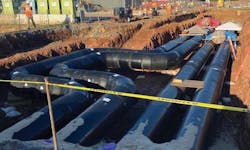Princeton University digging Geo-thermal options to provide low-carbon Heating, Cooling to Buildings
Construction on a new geo-exchange system to help Princeton University cut down on power plant energy needs and increase its pace toward Net Zero is under way.
The Ivy League school has contracted with numerous construction and engineering firms to bring heating and cool capacity to buildings on the New Jersey campus. The system includes hundreds of holes dug to between 600 and 800 feet below ground level.
Burns & McDonnell is handling engineering and program management. Other companies involved in the project include Whiting-Turner and Salas O'Brien.
“This is a situation where we’re able to capture energy that might otherwise be wasted and use it later,” Justin Grissom, a project manager for Kansas City-based Burns and McDonnell, said in a university story on the project. “Basically, the ground becomes a big battery, storing heat energy. It’s not an electrical battery, but a thermal battery.”
The two geo-exchange system have been planned for years as Princeton aims for net-zero carbon emissions from campus activities by its 300th anniversary in 2046. The school is also building a Central Utility building that should be completed by the fall.
The geo-exchange systems are expected for completion next year. Geo-exchange systems are dug more shallow than geothermal heat projects and use more moderate ground level locations to exchange heating and cooling from buildings.
Related stories
The Big IDEA: Creating Decarbonizaton and Resiliency for power at the Nation's Universities
Creating new Campus Power for Future Generation: A Case Study CHP Upgrades at UConn
Princeton currently has a steam distribution plant and cogeneration power facility to generate electricity on campus. Some of the facility’s components, however, date back to World War I era.
The school is investing several hundred million dollars on the Thermally Integrated Geo-Exchange Resource (TIGER) facility.
“We always talk about Princeton as a lighthouse institution that people pay attention to,” said Forrest Meggers, an associate professor of architecture and the Andlinger Center for Energy and the Environment, who also serves as co-chair of the Princeton Sustainability Committee. As a result, the University was “willing to take the more expensive pathway, because it’s important,” Meggers was quoted on the Princeton University website.
The Tiger system is being located across from Lake Carnegie.
Click here to read more about Princeton’s geo-exchange projects.
-- -- --
(Rod Walton, senior editor for EnergyTech, is a 14-year veteran of covering the energy industry both as a newspaper and trade journalist. He can be reached at [email protected]).
About the Author
Rod Walton, EnergyTech Managing Editor
Managing Editor
For EnergyTech editorial inquiries, please contact Managing Editor Rod Walton at [email protected].
Rod Walton has spent 17 years covering the energy industry as a newspaper and trade journalist. He formerly was energy writer and business editor at the Tulsa World. Later, he spent six years covering the electricity power sector for Pennwell and Clarion Events. He joined Endeavor and EnergyTech in November 2021.
Walton earned his Bachelors degree in journalism from the University of Oklahoma. His career stops include the Moore American, Bartlesville Examiner-Enterprise, Wagoner Tribune and Tulsa World.
EnergyTech is focused on the mission critical and large-scale energy users and their sustainability and resiliency goals. These include the commercial and industrial sectors, as well as the military, universities, data centers and microgrids. The C&I sectors together account for close to 30 percent of greenhouse gas emissions in the U.S.
He was named Managing Editor for Microgrid Knowledge and EnergyTech starting July 1, 2023
Many large-scale energy users such as Fortune 500 companies, and mission-critical users such as military bases, universities, healthcare facilities, public safety and data centers, shifting their energy priorities to reach net-zero carbon goals within the coming decades. These include plans for renewable energy power purchase agreements, but also on-site resiliency projects such as microgrids, combined heat and power, rooftop solar, energy storage, digitalization and building efficiency upgrades.

